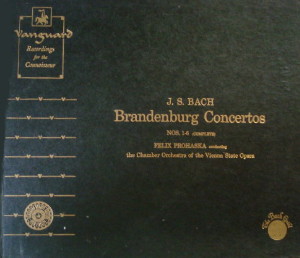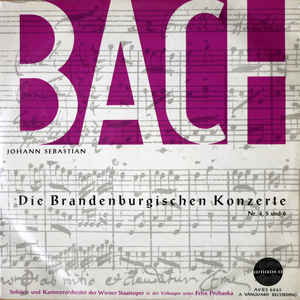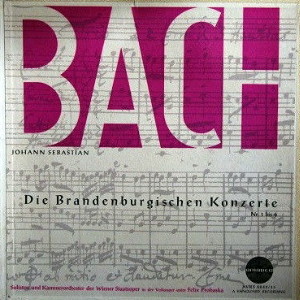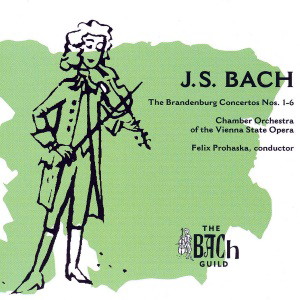 |
| 1 LP -
BG 542 - (p) 1954 |
 |
3 LP -
BG 540/42 - (p) 1954
|
 |
| 1 LP -
AVRS 6043 - (c) 19?? |
 |
| 2 LP -
AVRS 6042/43 - (c) 19?? |
 |
| 2 CD -
ATM-CD-1244 - (p) 2003 |
|
Johann Sebastian
Bach (1685-1750)
|
|
|
|
|
|
|
|
|
| Brandenburg
Concertos Nos. 1-6 |
|
|
|
|
|
|
|
|
| Concerto
No. 1 in F major, BWV 1046 |
- (Allegro) |
|
4' 23"
|
A1 |
|
-
Adagio |
|
4' 33" |
A2 |
|
- Allegro |
|
4' 54"
|
A3 |
|
-
Menuetto-Polonaise-Menuetto |
|
7' 54" |
A4 |
| Concerto No. 2 in F major,
BWV 1047 |
- (Allegro) |
|
5' 07"
|
B1 |
|
- Andante |
|
3' 51" |
B2 |
|
- Allegro assai |
|
2' 43" |
B3 |
| Concerto No. 3 in G major,
BWV 1048 |
- (Allegro) |
|
7' 12"
|
C1 |
|
- Adagio |
|
1' 56" |
C2 |
|
- Allegro |
|
6' 03" |
C3 |
| Concerto No. 4 in G major,
BWV 1049 |
- Allegro |
|
7' 10"
|
D1 |
|
- Andante |
|
3' 52" |
D2 |
|
- Presto |
|
5' 01" |
D3 |
| Concerto No. 5 in D major,
BWV 1050 |
- Allegro |
|
10' 56" |
E1 |
|
- Affettuoso |
|
4' 29" |
E2 |
|
- Allegro |
|
5' 24" |
E3 |
| Concerto No. 6 in B flat,
BWV 1051 |
- Allegro |
|
7' 26" |
F1 |
|
- Adagio ma non tanto |
|
4' 24" |
F2 |
|
- Allegro |
|
6' 10" |
F3 |
|
|
|
|
| Chamber Orchestra
of the Vienna State Opera / Felix
Prohaska, conductor |
|
| -
Jan Tomasow, violin and violino
piccolo* (1*,2,3,4,5) |
-
Helmut Wobisch, trumpet
(2) |
|
-
Rudolf Streng, violin (3)
|
-
Karl Trotzmüller, recorder
(4) |
|
-
Alfred Jilka, violin (3)
|
-
Paul Angerer, recorder
and viola* (4,6*) |
|
-
Wilhelm Hübner, viola (3,6)
|
-
Karl Mayrhofer, oboe
(1,2) |
|
-
Eduard Rab, viola (3)
|
-
Hans Reznicek, flute
(2,5) |
|
-
Ernst Kriss, viola (3)
|
-
Nicolas Harnoncourt, viola
da gamba (6) |
|
-
Richard Harand, 'cello (3,6)
|
-
Beatrice Reichert, viola
da gamba (6) |
|
-
Günther Weis, 'cello (3)
|
-
Anton Heiller, cembalo
(1,2,3,4,5,6) |
|
-
Ludwig Beinl, 'cello (3)
|
|
|
|
Luogo e data
di registrazione
|
| Brahmsaal, Vienna (Austria) -
marzo 1954 |
|
Registrazione
live / studio
|
| studio |
Producer / Engineer
|
Seymour Solomon
|
Prima Edizione
CD
|
Artemis Classics "The Bach
Guild" - ATM-CD-1244 - (2 cd) - 48' 35"
+ 54' 52" - (p) 2003 - AAD - mono
|
Prima
Edizione LP
|
-
Vanguard "The Bach Guild" - BG 542
- (1 lp) - 38' 49" - (p) 1954 (BWV
1050 e 1051)
- Vanguard "The
Bach Guild" - BG 540/42 - (3 lp) - 33'
25" + 31' 14" + 38' 49" - (p) 1954 (BWV
1046-1051)
-
Amadeo - AVRS 6043 - (1 lp) - 54'
52" - (c) 19?? (BWV 1049, 1050,
1051)
- Amadeo - AVRS 6042/43 - (2 lp) - 48'
35" + 54' 52" - (c) 19?? (BWV 1046-1051)
|
| Note |
| Harnoncourt è presente
solamente nel Concerto No. 6 BWV 1051. |
|
|
Notes on the program
|
|
The Brandenburg
concertos were composed while Bach was
in the service of the Prince of
Anhalt-Cöthen, an enlightened dilettante
who (on Bach's word) not only enjoyed
music but understood it. At Cöthen, the
stress was upon secular instrumental
music in which, very probably, the
Prince himself partecipated.
Undoubtedly, there was ample opportunity
for Bach during his stay at Cöthen
(1717-1723) to cultivate this field.
A visit of the Margrave of Brandenburg
to Cöthen, and some small encouragement
which Bach constred the Margrave to
have, tendered him, was apparently
sufficient to motivate the dedication
whic, dated 1721, reads in part as
follows:
"A couple of years ago, I had the
pleasure, in obedience to Your
Highness' commands, of appearing
before Your Highness and experiencing
Your condescending interest in the
small musical talents which Heaven has
disposed upon me; and since, upon
taking leave, I understood Your
Highness to honor me with a gracious
expression of willingness to accept
some pieces of my composition, I have
taken the Liberty, in compliance with
Your Highness' most gracious commands,
of tendering as my most humble duty to
Your Royal Highness, the present
concertos which I have adapted to
several instruments..."
Routinely, the Margrave is complimented
upon his "fine and delicate taste,"
implored not to judge the concertos by
their imperfections, but to infer from
them "the most profound respect and most
humble obedience" they are intended to
convey. In conclusion - and here we come
undoubtedly to the point of this long
winded flattery - Bach requests a
continuation of "Your Highness' gracious
favor," offering assurances of a
heartfelt wish to be "employed on
occasions more worthy of Your Royal
Highness and of Your Highness'
service..."
The tone of the dedication is entirely
proper and conventional for the period,
and marks rather plainly the social
status of a composer in relation to an
aristocratic patron. Written not in
Bach's native German, but in French, the
officinal language in 18th century
German courts, it tells us little of
Bach as an individual, for it is
obviously a routine social rather than a
personal document. Schweitzer makes the
rather large inference that Bach must
have been adept at this involved,
courtly French idiom. Spitta more
reasonably takes it for granted that
some courtier at Cöthen probably
supplied Bach with a document
conventional for such occasions. In any
case, there is nothing to indicate that
the Margrave remembered Bach, or found
his work interesting. There is no
evidence of an honorarium which custom
allowed a composer to expect, and it is
even possible that the works were not
performed. When the Margrave's library
was inventoried after his death, the
Bach works were not even listed, but
presumably included in two large lots
(77 and 100 respectively) labeled
"concertos by different masters and for
various intruments," and put up for sale
for what seems today a ridiculously low
price.
This set is typical of Bach's
"collections." In essence, a principle
of composition is selected - here a
concerto polarity of instrumental forces
- and then applied to cover a wide and
freely selected variety of
contingencies. In the main, a concerto
grosso technique - a small solo
unit (concertino) versus a larger
orchestral grouping (grosso or
ripieno) - is the dominating
principle; although sometimes, as in the
first concerto, this is so freely
handled as to evaporate almost entirely.
Usually, in place of a rogorous concerto
grosso definition between concertino
and grosso, the concertino
unit breaks up into its component
soloists, and at times a given solo
instrument assumes a role so prominent
as to cause the given movement to take
on temporarily the complextion of a solo
concerto.
The traditional concertino unit
of three strings (two violins and a
'cello) is modified both in number and
type of instruments. There is little
here of adherence to formula and much of
a perpetually varied and imaginative
exploration of the possibilities
inherent in the concerto relationship
between dissimilar and unbalanced bodies
of sound. Each concerto in the set
postulates a tonal imbalance peculiar to
it. The drive toward unity and balance
in the face of the obstacles Bach
deliberately designs for himself - and
it takes a Bach to design an obstacle
difficult enough to challenge a Bach -
sets up within the music an inner
momentum, an intrinsic sense of sheer
musical excitement, which the work of a
formula ridden academic can never
possess. The difficulty of reducing
these concertos to type, is almost
exactly proportional to the pleasure in
sensing the workings of a bold and
disciplined imagination, and in
responding to that sense of victorious
aesthetic accomplishment which each
concerto so satisyingly provides.
Notes (BG 540/42) by Abraham
Veinus, Music Department,
Syracuse University
|
|
About the Performance and
Recording
|
|
Felix Prohaska moved
from conductorship of the Duisberg and
Strassburg Opera to become, in 1945,
principal conductor of the Vienna State
Opera. His name has often been compared
by critics with that of Bruno Walter. To
his mastery of the romantic idiom he
adds a deep schooling in the Baroque
tradition. Of his recording of J. S.
Bach's Four Orchestral Suites
(BG-530/1) the New York Herald Tribune
wrote, "Musical scholarship and
ingenuity have produced a splendidly
authentic version of Bach's Four
Suites"; Paul Affelder described it as
"of prime artistic and musicological
significance"; the Cleveland Plain
Dealer as "an epochal release." His
recordings of J. S. Bach's Cantatas
Nos. 4 and 140 (BG-511) and of C.
P. E. Bach's Magnificat in D
(BG-516/7) were listed by B. H. Haggin
as among the outstanding releases of the
year.
Jan Tomasow has been soloist with the
major world orchestras and is presently
Concertmaster of the Little Orchestra
Society of New York. His versatility is
indicated by his performance of the violino
piccolo part in the First
Brandenburg Concerto and of the
fiendishly difficult modern writing for
violin in Stravinsky's L'Histoire du
Soldat (VRS-452, with Les
Noces). Amond his other celebrated
Vanguard and Bach Guild recordings are
Mozart's Divertimento in D. K. 334,
with Prohaska (VRS-441), which the New
York Herald Tribune called "a treat hard
to match," Mozart's Divertimento in
B flat K. 287 (VRS-444) and A
Bouquet of Vivaldi Concertos
(BG-538). Hans Reznickek and Helmut
Wobisch are, respectively, first flute
and first trumpet of The Vienna
Philharmonic Orchestra, Helmut Wobisch
is widely regarded as the outstanding
Bach trumpet player of Europe. Anton
Heiller is professor of composition and
organ in Vienna and acknowledged to be
one of the leading organists in Europe.
No effort has been spared to make this a
definitive version of Bach's great and
historic Brandenburg Concertos.
Especially important is the employment
of authentic Baroque instruments, such
as the viola-da-gamba, and the
recorder. Bach was a master of
instrumentation, as of every other
branch of composition, and looked on the
Brandenburg Concertos, as, among
other things, a treatise on the handling
of instrumental timbres. In his
concertos, as in his cantatas, he was
explicit as to where he wanted the
timbre of the cross-blown flute (flauto
traverso) and where that of the
recorder (Blöckflöte,
flute-ä-bec, flauto dolce).
The sweetness of the recorders is heard
in the Fourth Concerto, that of the
viola-da-gambas in the Sixth Concerto.
The violino piccolo, as directed
bz Bach, is emplozed in the First
Concerto. In the Second Concerto,
howewer, the flute is used instead of
the recorder, the technical difficulties
of which, in combination with the
brilliant high trumpet part would have
made the recording too hazardoust.
In the Third Brandenburg Concerto,
the corner movements are separated by a
cadenza improvised on the cembalo by
Anton Heiller, the Viennese master of
cembalo and organ. This is done in
accordance with the practice of Bach's
time where improvisation played a much
greater role than in performance today.
This recording is guaranteed to be
indical in sound to the original master
tapes from which it was made. Every
subtle nuance of the original
performance has been captured to enhance
your musical pleasure.
Ampex model 300 magnetic tape recorders
in conjunction with the Altec and the
new miracle remote controlled
Siemens-AKG C-12 condenser microphone
were utilized to produce the original
masters which embody a frequency
response covering the entire range of
human hearing and embrace the full gamut
of orchestral and vocal sonorities.
The recordings was made by Vanguard
engineers on location in the Brahmssaal,
Vienna, Austria - world renowned for its
superb acoustical characteristics.
Supervision was by Symour Solomon, Music
Director of Vanguard Recording Society,
Inc.. To realize the extraordinary
dynamic range of this recording it is
advised to play it at full room volume.
Compensate for the RIAA curve in
playback.
|
|
Nikolaus
Harnoncourt (1929-2016)
|

|

|
|